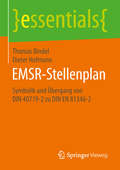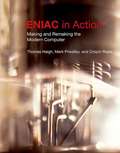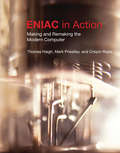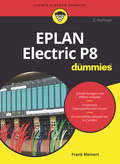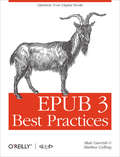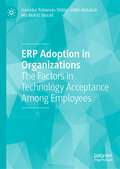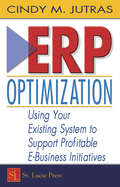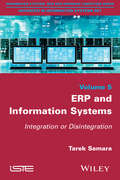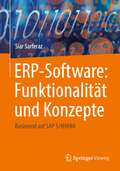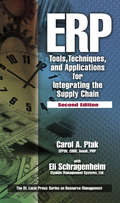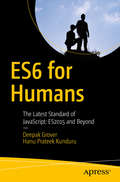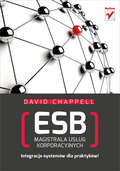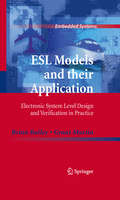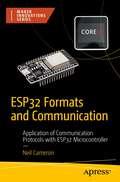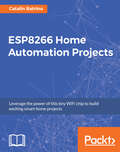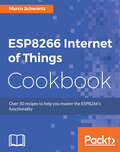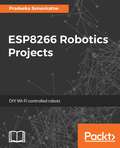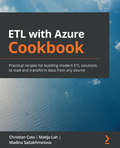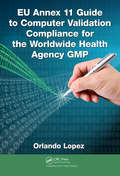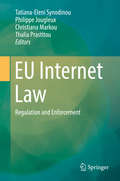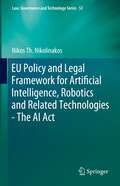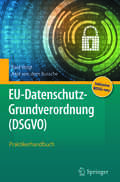- Table View
- List View
EMBOSS Developer's Guide:
by Mr Peter Rice Dr Alan Bleasby Dr Jon Ison Dr Jon Ison Mr Peter RiceThe European Molecular Biology Open Software Suite (EMBOSS) is a high quality, well documented package of open source software tools for molecular biology. EMBOSS includes extensive and extensible C programming libraries, providing a powerful and robust toolkit for developing new bioinformatics tools from scratch. The EMBOSS Developer's Manual is the official and definitive guide to developing software under EMBOSS. It includes comprehensive reference information and guidelines, including step-by-step instructions and real-world code examples: • Learn how to write fully-featured tools guided by the people who developed EMBOSS • Step-by-step guide to writing EMBOSS applications, illustrated with functional, deployed code • ACD file development – learn how to customise existing tools without coding, or design and write entirely new application interfaces • EMBOSS API programming guidelines – quickly master application development • Wrapping and porting applications under EMBOSS – learn how to incorporate third-party tools
EMSR-Stellenplan: Symbolik Und Übergang Von Din 40719-2 Zu Din En 81346-2 (Essentials)
by Dieter Hofmann Thomas BindelThomas Bindel und Dieter Hofmann ordnen EMSR- bzw. PCE-Stellenpläne als wichtige Unterlagen der Projektierung von Automatisierungsanlagen ein. DIN 19227-2 gilt weiterhin, jedoch wurde DIN 40719-2 zurückgezogen und durch DIN EN 81346-2 ersetzt. Da in EMSR-Stellenplänen bereits existierender Anlagen Betriebsmittel nach DIN 40719-2 gekennzeichnet wurden, stehen Anwender vor einer Herausforderung: Sie müssen diese Norm nach wie vor verstehen, für Neuanlagen in EMSR- bzw. PCE-Stellenplänen zur Referenzkennzeichnung jedoch statt DIN 40719-2 die sich eher zögerlich durchsetzende DIN EN 81346-2 anwenden. Die Autoren beleuchten die mit diesem Übergang verbundenen Änderungen und geben so Orientierung zur Nutzung von DIN EN 81346 für das Fachgebiet der Projektierung von Automatisierungsanlagen.Die AutorenProf. Dr.-Ing. Thomas Bindel lehrt Automatisierungstechnik an der Fakultät Elektrotechnik der Hochschule für Technik und Wirtschaft Dresden. Priv.-Doz. Dr.-Ing. Dieter Hofmann lehrte und lehrt Prozessautomatisierung an der TU Dresden sowie an der Staatlichen Studienakademie Bautzen.
ENIAC in Action: Making and Remaking the Modern Computer
by Mark Priestley Crispin Rope Thomas HaighConceived in 1943, completed in 1945, and decommissioned in 1955, ENIAC (the Electronic Numerical Integrator and Computer) was the first general-purpose programmable electronic computer. But ENIAC was more than just a milestone on the road to the modern computer. During its decade of operational life, ENIAC calculated sines and cosines and tested for statistical outliers, plotted the trajectories of bombs and shells, and ran the first numerical weather simulations. ENIAC in Action tells the whole story for the first time, from ENIAC's design, construction, testing, and use to its afterlife as part of computing folklore. It highlights the complex relationship of ENIAC and its designers to the revolutionary approaches to computer architecture and coding first documented by John von Neumann in 1945.Within this broad sweep, the authors emphasize the crucial but previously neglected years of 1947 to 1948, when ENIAC was reconfigured to run what the authors claim was the first modern computer program to be executed: a simulation of atomic fission for Los Alamos researchers. The authors view ENIAC from diverse perspectives -- as a machine of war, as the "first computer," as a material artifact constantly remade by its users, and as a subject of (contradictory) historical narratives. They integrate the history of the machine and its applications, describing the mathematicians, scientists, and engineers who proposed and designed ENIAC as well as the men -- and particularly the women who -- built, programmed, and operated it.
ENIAC in Action: Making and Remaking the Modern Computer (History of Computing)
by Mark Priestley Crispin Rope Thomas HaighThe history of the first programmable electronic computer, from its conception, construction, and use to its afterlife as a part of computing folklore.Conceived in 1943, completed in 1945, and decommissioned in 1955, ENIAC (the Electronic Numerical Integrator and Computer) was the first general-purpose programmable electronic computer. But ENIAC was more than just a milestone on the road to the modern computer. During its decade of operational life, ENIAC calculated sines and cosines and tested for statistical outliers, plotted the trajectories of bombs and shells, and ran the first numerical weather simulations. ENIAC in Action tells the whole story for the first time, from ENIAC's design, construction, testing, and use to its afterlife as part of computing folklore. It highlights the complex relationship of ENIAC and its designers to the revolutionary approaches to computer architecture and coding first documented by John von Neumann in 1945.Within this broad sweep, the authors emphasize the crucial but previously neglected years of 1947 to 1948, when ENIAC was reconfigured to run what the authors claim was the first modern computer program to be executed: a simulation of atomic fission for Los Alamos researchers. The authors view ENIAC from diverse perspectives—as a machine of war, as the “first computer,” as a material artifact constantly remade by its users, and as a subject of (contradictory) historical narratives. They integrate the history of the machine and its applications, describing the mathematicians, scientists, and engineers who proposed and designed ENIAC as well as the men—and particularly the women who—built, programmed, and operated it.
EPLAN Electric P8 für Dummies (Für Dummies)
by Frank MeinertSie arbeiten mit EPLAN Electric P8 und wollen wissen, wie Sie Schaltpläne ohne Umwege zeichnen und umfassend auswerten? Hinsetzen, Buch aufschlagen, Kapitel für Kapitel durcharbeiten, fertigen Schaltplan haben! Dieses Buch ermöglicht Ihnen einen schnellen und effektiven Einstieg in EPLAN Electric P8 und enthält die besten Tricks für den Umgang mit dem Programm. Anhand eines Beispielprojekts werden Sie Schritt für Schritt an das Programm herangeführt. Und die Beispieldateien werden auch noch zum Download angeboten. So können Sie sehr schnell gewinnbringend arbeiten.
EPUB 3 Best Practices: Optimize Your Digital Books (Oreilly And Associate Ser.)
by Matt Garrish Markus GyllingReady to take your ebooks to the next level with EPUB 3? This concise guide includes best practices and advice to help you navigate the format’s wide range of technologies and functionality. EPUB 3 is set to turn electronic publishing on its head with rich multimedia reading experiences and scripted interactivity, but this specification can be daunting to learn. This book provides you with a solid foundation.Written by people involved in the development of this specification, EPUB 3 Best Practices includes chapters that cover unique aspects of the EPUB publishing process, such as technology, content creation, and distribution.Get a comprehensive survey of accessible production featuresLearn new global language-support features, including right-to-left page progressionsEmbed content with EPUB 3’s new multimedia elementsMake your content dynamic through scripting and interactive elementsWork with publication and distribution metadataCreate synchronized text and audio playback in reading systemsLearn techniques for fixed and adaptive layouts
ERP Adoption in Organizations: The Factors in Technology Acceptance Among Employees
by Hamidur Rahaman Shibly ABM Abdullah Md Wahid MuradThis book examines the factors that shape the adoption and continuous usage of new technology by employees in organizations. While within an organization new technology adoption has evolved from its traditional role to a more strategic one, the appropriate adoption of new technology can only add value to organizations. Identifying the factors that influence this adoption process is crucial for successful adoption of new technology in organizations. The study presented in this book focuses on individual, organizational, social, and industrial factors and uses those to offer a comprehensive model of Enterprise Resource Planning (ERP) application adoption. It contributes towards understanding employees’ acceptance and adoption of enterprise-level technological innovation, allowing organizations to create a work environment conducive to individual implementation and acceptance of new technology. It appeals to researchers interested in studying the adoption of ERP and other innovative technologies in organizations.
ERP Optimization: Using Your Existing System to Support Profitable E-Business Initiatives
by Cindy JutrasExisting ERP systems are being used to support an increasing amount of critical e-business initiatives, even though this is far from their original purpose. While ERP can form a foundation for successfully meeting e-business needs, future success will be derived not only from a firm, supportive foundation, but from a solid e-business superstructure
ERP Systems for Manufacturing Supply Chains: Applications, Configuration, and Performance
by Odd Jøran Sagegg Erlend AlfnesERP Systems for Manufacturing Supply Chains: Applications, Configuration, and Performance provides insight into the core architecture, modules, and process support of ERP systems used in a manufacturing supply chain. This book explains the building blocks of an ERP system and how they can be used to increase performance of manufacturing supply chains. Starting with an overview of basic concepts of supply chain and ERP systems, the book delves into the core ERP modules that support manufacturing facilities and organizations. It examines each module’s structure and functionality as well as the process support the module provides. Cases illustrate how the modules can be applied in manufacturing environments. Also covered is how the ERP modules can be configured to support manufacturing supply chains. Setting up an ERP system to support the supply chain within single manufacturing facility provides insight into how an ERP system is used in the smallest of manufacturing enterprises, as well as lays the foundation for ERP systems in manufacturing organizations. The book then supplies strategies for larger manufacturing enterprises and discusses how ERP systems can be used to support a complete manufacturing supply chain across different facilities and companies. The ERP systems on the market today tend to use common terminology and naming for describing specific functions and data units in the software. However, there are differences among packages. The book discusses various data and functionalities found in different ERP-software packages and uses generic and descriptive terms as often as possible to make these valid for as many ERP systems as possible. Filled with insight into ERP system’s core modules and functions, this book shows how ERP systems can be applied to support a supply chain in the smallest of manufacturing organizations that only consist of a single manufacturing facility, as well as large enterprises where the manufacturing supply chain crosses multiple facilities and companies.
ERP and Information Systems
by Tarek SamaraThis research attempts to explore and identify eventual relationships between the evolution of ERP systems and information systems integration or disintegration. The aim of this research is to know if the relationships between the ERP systems and the information systems are guided by certain factors and, as a result, to understand, more in-depth, the factors affecting these relationships. More precisely, this analysis aims to study whether assigned values given to these factors could guide the evolution of ERP systems in a manner that promotes IS integration; and if the opposite assigned values to these same factors could guide the evolution of ERP systems in a manner that provokes IS disintegration instead.
ERP-Software: Basierend auf SAP S/4HANA
by Siar SarferazEnterprise Resource Planning (ERP) ist eine Software Lösung, die alle Prozesse eines Unternehmens digitalisiert, mit dem Ziel den Automatisierungsgrad zu erhöhen. SAP bietet mit SAP S/4HANA die nächste Generation eines intelligenten ERP-Systems. Das Buch erläutert den Funktionsumfang, das Datenmodell, die Architektur, die zugrundeliegenden Engineering Konzepte und das Programmiermodell von ERP-Systemen basierend auf SAP S/4HANA.Im ersten Teil lernen interessierte Leser*innen die Marktsicht von ERP kennen. Der zweite Teil behandelt die ERP-Geschäftsprozesse für Vertrieb, Marketing, Finanzwesen, Lieferketten, Fertigung, Dienstleistungen, Beschaffung und Personalwesen. Im dritten Teil werden die zugrundeliegenden Konzepte beschrieben, z. B. In-Memory Datenbanken, Analytics und Reporting, Künstliche Intelligenz, Prozess- und Datenintegration, Sicherheit und Compliance, Lebenszyklusmanagement, Performanz und Skalierbarkeit, Konfiguration und Implementierung. Das Buch schliesst mit der Beschreibung und einer Testzugangs-Möglichkeit zur SAP Cloud Appliance Library, mit dem die Leserschaft das SAP S/4HANA System selbst erkunden kann.
ERP: Tools, Techniques, and Applications for Integrating the Supply Chain, Second Edition (Resource Management)
by Eli Schragenheim Carol A PtakCompletely revised and updated, ERP: Tools, Techniques, and Applications for Integrating the Supply Chain, Second Edition describes, from the perspective of a business manager, concepts and tools for enterprise planning, management, and execution. The text is written in an easy-to-read format, with many real examples from a variety of industries th
ES6 for Humans
by Deepak Grover Hanu Prateek KunduruLearn ES6 best practices for code optimization and organization and walk through practical, common examples of how to implement complete components of your applications. While this book covers the basic concepts of modern JavaScript, it primarily focuses on the new syntax, data-types, functionalities, and everything else that's new in ES6, the latest standard of JavaScript. You'll examine how to use ES6 in functional programming and explore the new more modular and object-oriented approach to JavaScript. This book will help you sharpen and upgrade your JavaScript language skills so you to easily explore modern ES6 based frameworks or libraries such as ReactJS, ReactNative, Angular4 and Vue. js. ES6 for Humans is a complete guide to writing ES6 and will enable you to start taking advantage of this exciting new version of JavaScript. What You'll Learn Use all the new features added to JavaScript Compare ES5 and ES6 in varied situations Refresh your core JavaScript fundamentals Understand the modular and object-oriented approach to JavaScript Who this Book Is For Any Javascript developer who wants to fully understand and dive into the new features of ES6/ES2015. Developers with some background in programming, preferably in JavaScript. A basic understanding of coding concepts and exposure to object-oriented programming is expected.
ESB. Magistrala us?ug korporacyjnych
by David A ChappellIntegracja systemów dla praktyków!Integracja systemów oraz zapewnienie komunikacji mi?dzy ró?nymi ich komponentami to ogromne wyzwanie. Podczas tworzenia w?asnych rozwi?za? prawdopodobnie natkniesz si? na dziesi?tki problemów. Dlatego warto rozwa?y? mo?liwo?? wykorzystania sprawdzonych narz?dzi. Nale?y do nich magistrala ESB (skrót od ang. Enterprise Service Bus). Magistrala taka zapewnia inteligentne zarz?dzanie ruchem, transformacj? danych, przesy?anie komunikatów i nie tylko. Brzmi obiecuj?co? Przekonaj si? sam!Si?gnij po t? ksi??k? i poznaj interesuj?ce strategie wykorzystania ESB. Na pocz?tku znajdziesz podstawy — w?a?ciwo?ci magistrali, jej histori? oraz formaty wymiany komunikatów. Z kolejnych rozdzia?ów dowiesz si?, jak skutecznie integrowa? us?ugi, wywo?ywa? komunikaty oraz korzysta? z niestandardowych adapterów. Ponadto skupisz si? na aspektach zwi?zanych z bezpiecze?stwem magistrali oraz jej konfiguracj?. Nauczysz si? równie? radzi? sobie w przypadku wyst?pienia problemów z przepustowo?ci? magistrali oraz opó?nieniami transferu. Ksi??ka ta jest unikaln? pozycj?, po?wi?con? interesuj?cym zagadnieniom zwi?zanym z magistral? ESB. Jest to Twoja lektura obowi?zkowa!Dzi?ki tej ksi??ce: poznasz mo?liwo?ci magistrali ESB skonfigurujesz j? i wykorzystasz jej potencja? rozwi??esz typowe problemy zintegrujesz ró?ne systemy — niezale?nie od tego, czy to .NET czy Java!Poznaj zaawansowane techniki integracji systemów!
ESL Models and their Application
by Brian Bailey Grant MartinThis book arises from experience the authors have gained from years of work as industry practitioners in the field of Electronic System Level design (ESL). At the heart of all things related to Electronic Design Automation (EDA), the core issue is one of models: what are the models used for, what should the models contain, and how should they be written and distributed. Issues such as interoperability and tool transportability become central factors that may decide which ones are successful and those that cannot get sufficient traction in the industry to survive. Through a set of real examples taken from recent industry experience, this book will distill the state of the art in terms of System-Level Design models and provide practical guidance to readers that can be put into use. This book is an invaluable tool that will aid readers in their own designs, reduce risk in development projects, expand the scope of design projects, and improve developmental processes and project planning.
ESP32 Formats and Communication: Application of Communication Protocols with ESP32 Microcontroller (Maker Innovations Series)
by Neil CameronAlthough Wi-Fi communication is incorporated in many internet-based applications, knowledge of alternative communication protocols is vital for optimal project development with a microcontroller, such as the ESP32. This book focuses on communication protocols for the ESP32 microcontroller with illustrative projects ranging from a Bluetooth Low Energy beacon communicating with your smart wristwatch to Long Range (LoRa) communication between microsatellites circling 550km above the Earth and an ESP32 microcontroller in your home. Just as there are different communication protocols, there are different ESP32 microcontroller formats. You’ll examine the features of several ESP32 microcontroller formats, which enable the optimal combination of communication protocol and ESP32 format to achieve the requirements of a project. Several of the communication protocols and ESP32 formats have only been available in the last few months or years, making the book very relevant. Each chapter focuses on a communication protocol and is stand-alone, so they can be read without having to start from the beginning of the book. The chapters are loosely grouped into short- and long-range communication, image management for transmission to a webpage or a remote LCD screen, and the required apps and IoT techniques for remote control of an ESP32-CAM robot vehicle. The advantages of each communication protocol correspond to different project types. What You'll Learn Study the MESH communication protocol and the ESP-NOW protocol with communication between ESP32 microcontrollers without a Wi-Fi connectionReview email communication projects with an ESP32 and generation of quick response codes to instruct an ESP32 to control a connected device.Look at the ESP32-CAM module built around a 2M-pixel camera for streaming images with the WebSocket protocol to a remote ESP32Control an ESP32-CAM robot car through remote communication over the internet with image streaming to an Android tablet or mobile phone.Who This Book Is For
ESP8266 Home Automation Projects
by Catalin BatrinuUnleash the power of the ESP8266 and build a complete home automation system with it. About This Book • Harness the power of the ESP8266 Wi-Fi chip to build an effective Home Automation System • Learn about the various ESP8266 modules • Configuring the ESP8266 and making interesting home automation projects • A step-by-step guide on the ESP8266 chip and how to convert your home into a smart home. Who This Book Is For This book is targeted at people who want to build connected and inexpensive home automation projects using the ESP8266 Wi-Fi chip, and to completely automate their homes. A basic understanding of the board would be an added advantage What You Will Learn • Get, compile, install, and configure an MQTT server • Use the Wi-Fi connectivity feature to control appliances remotely • Control several home appliances using the ESP8266 Wi-Fi chip • Control and monitor your home from the cloud using ESP8266 modules • Stream real-time data from the ESP8266 to a server over WebSockets • Create an Android mobile application for your project In Detail The ESP8266 is a low-cost yet powerful Wi-Fi chip that is becoming more popular at an alarming rate, and people have adopted it to create interesting projects. With this book, you will learn to create and program home automation projects using the ESP8266 Wi-Fi chip. You will learn how to build a thermostat to measure and adjust the temperature accordingly and how to build a security system using the ESP8266. Furthermore, you will design a complete home automation system from sensor to your own cloud. You will touch base on data monitoring, controlling appliances, and security aspects. By the end of the book, you will understand how to completely control and monitor your home from the cloud and from a mobile application. You will be familiar with the capabilities of the ESP8266 and will have successfully designed a complete ready-to-sell home automated system. Style and approach A practical book that will cover independent home automation projects.
ESP8266 Internet of Things Cookbook
by Marco SchwartzExploring the low cost WiFi module About This Book • Leverage the ESP8266's on-board processing and storage capability • Get hand- on experience of working on the ESP8266 Arduino Core and its various libraries • A practical and enticing recipe-based book that will teach you how to make your environment smart using the ESP8266 Who This Book Is For This book is targeted at IOT enthusiasts who are well versed with electronics concepts and have a very basic familiarity with the ESP8266. Some experience with programming will be an advantage. What You Will Learn • Measure data from a digital temperature and humidity sensor using the ESP8266 • Explore advanced ESP8266 functionalities • Control devices from anywhere in the world using MicroPython • Troubleshoot issues with cloud data monitoring • Tweet data from the Arduino board • Build a cloud-connected power-switch with the ESP8266 • Create an ESP8266 robot controlled from the cloud In Detail The ESP8266 Wi-Fi Module is a self contained System on Chip (SOC) with an integrated TCP/IP protocol stack and can give any microcontroller access to your Wi-Fi network. It is capable of either hosting an application or offloading all Wi-Fi networking functions from another application processor. This book contains practical recipes that will help you master all ESP8266 functionalities. You will start by configuring and customizing the chip in line with your requirements. Then you will focus on core topics such as on-board processing, sensors, GPIOs, programming, networking, integration with external components, and so on. We will also teach you how to leverage Arduino using the ESP8266 and you'll learn about its libraries, file system, OTA updates, and so on. The book also provide recipes on web servers, testing, connecting with the cloud, and troubleshooting techniques. Programming aspects include MicroPython and how to leverage it to get started with the ESP8266. Towards the end, we will use these concepts and create an interesting project (IOT). By the end of the book, readers will be proficient enough to use the ESP8266 board efficiently. Style and approach This recipe-based book will teach you to build projects using the ESP8266.
ESP8266 Robotics Projects
by Pradeeka SeneviratneBuild simple yet amazing robotics projects using ESP8266 About This Book • Get familiar with ESP8266 and its features. • Build Wi-FI controlled robots using ESP8266 • A project based book that will use the ESP8266 board and some of its popular variations to build robots. Who This Book Is For This book is targeted at enthusiasts who are interested in developing low-cost robotics projects using ESP8266. A basic knowledge of programming will be useful but everything you need to know is are covered in the book. What You Will Learn • Build a basic robot with the original ESP8266, Arduino UNO, and a motor driver board. • Make a Mini Round Robot with ESP8266 HUZZAH • Modify your Mini Round Robot by integrating encoders with motors • Use the Zumo chassis kit to build a line-following robot by connecting line sensors • Control your Romi Robot with Wiimote • Build a Mini Robot Rover chassis with a gripper and control it through Wi-Fi • Make a robot that can take pictures In Detail The ESP8266 Wi-Fi module is a self-contained SOC with an integrated TCP/IP protocol stack and can give any microcontroller access to your Wi-Fi network. It has a powerful processing and storage capability and also supports application hosting and Wi-Fi networking. This book is all about robotics projects based on the original ESP8266 microcontroller board and some variants of ESP8266 boards. It starts by showing all the necessary things that you need to build your development environment with basic hardware and software components. The book uses the original ESP8266 board and some variants such as the Adafruit HUZZAH ESP8266 and the Adafruit Feather HUZZAH ESP8266 . You will learn how to use different type of chassis kits, motors, motor drivers, power supplies, distribution boards, sensors, and actuators to build robotics projects that can be controlled via Wi-Fi. In addition, you will learn how to use line sensors, the ArduiCam, Wii Remote, wheel encoders, and the Gripper kit to build more specialized robots. By the end of this book, you will have built a Wi-Fi control robot using ESP8266. Style and approach A project-based guide that will help you build exciting robotics using ESP8266.
ETL with Azure Cookbook
by Christian Cote Matija LahThis book is for data warehouse architects, ETL developers, and anyone who wants to build scalable ETL applications in Azure. It is also relevant for those looking to extend their existing on-premises ETL applications to use big data and a variety of Azure services. If you want to migrate your existing on-premises solutions to the Azure cloud platform, you’ll find this book useful. Familiarity with SQL Server services is necessary.
EU Annex 11 Guide to Computer Validation Compliance for the Worldwide Health Agency GMP
by Orlando LopezGood Manufacturing Practice (GMP) ensures medicinal products are produced consistently and controlled to the quality standards appropriate for their intended use and as required by product specifications or marketing authorization. Annex 11 details the European Medicines Agency (EMA) GMP requirements for computer systems.The purpose of Annex 11 is
EU Competition Law, the Consumer Interest and Data Protection
by Federico FerrettiThe legitimacy or illegitimacy of information exchanges between competitors remains a topical debate with regard to EU competition law and policy. This book reexamines the issue in the retail financial services sector, focusing on the peculiar problems that it poses for EU market integration, consumer policy and protection and the intersection with fundamental rights. It analyzes and reflects on the relevant case law and guidelines offered by the corresponding European authorities, providing a critique of the current approach and advancing the proposition that information markets themselves need attention, in addition to the markets that they serve. The book also advances new perspectives on cases in which consumers' personal information is involved in the exchange, recognizing the inevitable interaction between EU competition law, the interests and protection of consumers and personal data protection. It suggests that the status quo under competition law is unsatisfactorily short sighted and that the EU should take a holistic approach (including information markets) to the analysis of competition law, reflecting consumer protection and fundamental rights aspects in the assessment.
EU Internet Law
by Tatiana-Eleni Synodinou Philippe Jougleux Christiana Markou Thalia PrastitouThis book provides an overview of recent and future legal developments concerning the digital era, to examine the extent to which law has or will further evolve in order to adapt to its new digitalized context. More specifically it focuses on some of the most important legal issues found in areas directly connected with the Internet, such as intellectual property, data protection, consumer law, criminal law and cybercrime, media law and, lastly, the enforcement and application of law. By adopting this horizontal approach, it highlights - on the basis of analysis and commentary of recent and future EU legislation as well as of the latest CJEU and ECtHR case law - the numerous challenges faced by law in this new digital era. This book is of great interest to academics, students, researchers, practitioners and policymakers specializing in Internet law, data protection, intellectual property, consumer law, media law and cybercrime as well as to judges dealing with the application and enforcement of Internet law in practice.
EU Policy and Legal Framework for Artificial Intelligence, Robotics and Related Technologies - The AI Act (Law, Governance and Technology Series #53)
by Nikos Th. NikolinakosArtificial Intelligence (AI) can benefit our society and economy, but also brings with it new challenges and raises legal and ethical questions. According to the author of this comprehensive analysis, it is imperative to ensure that AI is developed and applied in an appropriate legal and regulatory framework that promotes innovation and investment and, at the same time, addresses the risks associated with certain uses of AI-related technologies.Essential to understanding the relationship between policy and law, this book traces the evolution of EU policy on artificial intelligence and robotics, focusing in particular on the EU’s ethical framework for AI, which defines trust as a prerequisite for ensuring a human-centric approach.The main part of the book provides a thorough and systematic analysis of the Commission’s 2021 proposed AI Act, which establishes harmonised rules for the development, placement on the market and use of AI systems in the EU. The author painstakingly compares the Commission’s proposed AI Act with the numerous “compromise” proposals of the Council of the European Union, leading to the final version of the Council’s AI Act (general approach) and its formal adoption on 6 December 2022. The author also examines with extraordinary detail the amendments proposed by the relevant committees and political groups of the European Parliament, revealing the position the Parliament is likely to adopt in the forthcoming negotiations with the Commission and the Council on the text of the AI Act.Numerous legislative and policy documents are presented in detail, while the analysis also considers the comments made by all interested parties (e.g. the European Commission, Council of the European Union, European Parliament, governmental organisations, national competent authorities, and stakeholders/actors with different/conflicting interests, such as corporations, business and consumer associations, civil society and other non-profit organisations). In the course of its in-depth analysis, this book will provide readers with crucial insight into the reasons behind the European Institutions’ different approaches and the often contradictory interests of stakeholders. Because the policy arguments are carefully balanced and drafted with scrupulous care, this volume will establish itself as a reference resource to be consulted for years to come.
EU-Datenschutz-Grundverordnung (DSGVO)
by Paul Voigt Axel von dem BusscheDieses Praktikerhandbuch enthält Hinweise zur praktischen Umsetzung der EU-Datenschutz-Grundverordnung (DSGVO) sowie eine systematische Analyse der neuen Vorschriften. Das Handbuch widmet sich unter anderem den organisatorischen und materiellen Datenschutzanforderungen, den Rechten der betroffenen Personen, der Rolle der Aufsichtsbehörden, der Rechtsdurchsetzung und den Bußgeldern nach der Verordnung, sowie nationalen Besonderheiten. Das deutsche Datenschutz-Anpassungs- und Umsetzungsgesetz EU (DSAnpUG-EU) wurde bereits umfassend berücksichtigt. Zusätzlich gewährt das Handbuch einen kompakten Überblick zu den Konsequenzen der Neuregelung für ausgewählte Verarbeitungssituationen mit hoher Praxisrelevanz, wie Cloud Computing, Big Data und Internet of Things. Die im Jahr 2016 verabschiedete DSGVO tritt im Mai 2018 in Kraft. Sie sieht zahlreiche neue bzw. verstärkte Datenschutzpflichten sowie eine deutliche Erhöhung der Bußgelder (auf bis zu 20 Mio. Euro) vor. Nicht nur in der Europäischen Union ansässige Unternehmen werden daher ihre Datenschutz-Compliance auf den Prüfstand stellen müssen; aufgrund des weiten, grenzüberschreitenden Anwendungsbereichs der Verordnung wird ihr Inkrafttreten Auswirkungen auf zahlreiche Unternehmen weltweit haben.

